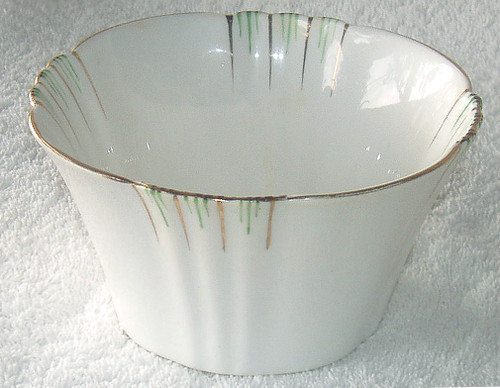HISTORY:
We do not usually have any Limoges in my wife's private collection and ended up with this piece "accidently" quite a few years ago, actually there were originally two pieces - a set. Our friends were travelling Europe & UK when they came across this set of vases. Knowing that my wife loves English & Irish chinaware's, they bought the vases back to Australia for her. Simple mistake to make but this is not English or Irish chinaware but in fact French Limoges porcelain. Alas, not all went well and one vase was destroyed in the hand luggage! This is it's remaining partner.
Not knowing what to do with this solitary vase, she put it away on one of the china display cabinet shelves, towards the rear and forgot all about it until today!
Last week it came out of the china cabinet as she wants it to find a new owner who will appreciate and care for it in the manner it deserves!
Please read the description below entirely, look at the photographs and make your own judgement about the suitability of this vase for your collection ... my wife does NOT trade in china or porcelain but she does collect pieces, particularly those which are hand painted and OLD, the older the better! Oh my word! she has collected a lot over the years (take a good look around our website)
We are not appraisers nor experts in Limoges but do have a basic knowledge of this special porcelain.
Here we go ...
UNKNOWN MAKER OR DECORATOR - Limoges Vase
Made in Limoges, France (of course!)
Stands 8.25" tall x 5" diameter at the widest point
The mouth is 1.25" diameter
Weight: 550g
Decoration: All decoration has been hand applied by the artist(s) NO decals or transfers used
Background colouring smoothly varies from a Yellow Green through to a Lime Green
One side is dominated by Pink & Red Roses with the other side having just foliage. The intensity of the foliage varies, in some areas it is very faint and in others much more dominant.
SPECIAL NOTE:
Notice the top rim decoration and the base.
The top rim looks for all the world as though gem stones have been pressed into the White clay but in fact they are also hand decorated, the 'diamond' shape of those "stones" is actually pressed from inside the blank, outwards - they are not stones that have been added at all.
The base is also patterned but there are none of those "stone like" decorations however it should be noted that the actual pattern which is heavily Gold gilded (dull finish) has been "pushed" into the blank.
You can look inside the Olive Green mouth of the vase and see all of these depressions and ridges in the clay which have been used to create those external textures to the vase.
The clay inside and underneath is bright White and yes, it is translucent - shine a strong light source on the outside wall of the vase and you can easily see the light on the inside of the vase.
The decorations are not bright, flashy or gordy! Very subdued, pale looking but interestingly the colours seem to 'come alive' when subjected to the flash camera I used.
The overall glaze finish is something like a satin finish, not glossy at all
Usually these Limoges blanks were made by a company using the special clay and then the decoration of the item was 'outsourced' to an artist
MYSTERY NUMBER 1:
This vase IS SIGNED but we cannot find out who the person is or who they worked for!
Up near the top rim, near the top of the Red Rose bud is the word Périer in Brown 'running script ' - this name is orientated vertically (running up and down the vase) and it is VERY SMALL and only 9mm in length. This name has been hand written and it is UNDER the glaze (I think, it is hard to tell) so we would imagine this is quite difficult to do - it is so small!
I have included a photograph of the area where this signature has been placed.
MYSTERY NUMBER 2:
The Whitestamp underneath ... there is a LOT of information here but we do not understand what it all means, not through lack of trying but it seems that the world of Limoges is a complicated one so we gave up looking!
I have included a photograph of the underside of this vase, perhaps this may assist working out just what all these marks mean ...
Incised into the clay are two lines of writing
g C 43
I (with a line added at a sharp angle to the base) 8
Next is the hand applied painted markings (Light Brown)

9043
9008
11
Lastly off near the rim of the base, again in Light Brown is
12
COSMETIC CONDITION:
NO chips
NO crazing
Some light Brown discolouration in a couple of places externally, possibly bacteria has entered under the glazing.
NO wear observed to the heavily applied "Old Gold" gilding, both top and bottom.
Two "flaws", which made us wonder a little, were observed upon close inspection of the vase.
(1) While trying to figure out the signature near the top rim, we noticed right down near the base is a very small patch of discolouration AND an X applied with a fine Black pen (under the glaze) It is very hard to see but it is there.
Perhaps this vase came back from the artist and the company rejected it? We truly have no idea about this theory.
(2) There is a faint line, again near the base which we intially took to be a crack. We now believe it is not a crack at all but in fact a scratch! It is shaped in a downwards arc and even crosses (partially) some of the Gold gilding at the base. Using the fingers, it doesn't feel like a crack and it is too uniform - it is as though someone has run a protractor around the side of the vase! It is quite difficult to see but I have tried to capture it in one of the photographs.
Looking inside, I cannot see this mark except a slight Brownish discolouration which suggests the scratch has broken through the glaze and again, bacteria has gone there to live!
We hope this quite detailed description will assist someone who may be collecting such things, it certainly does not "fit in" with our late 19th Century English wares!




















